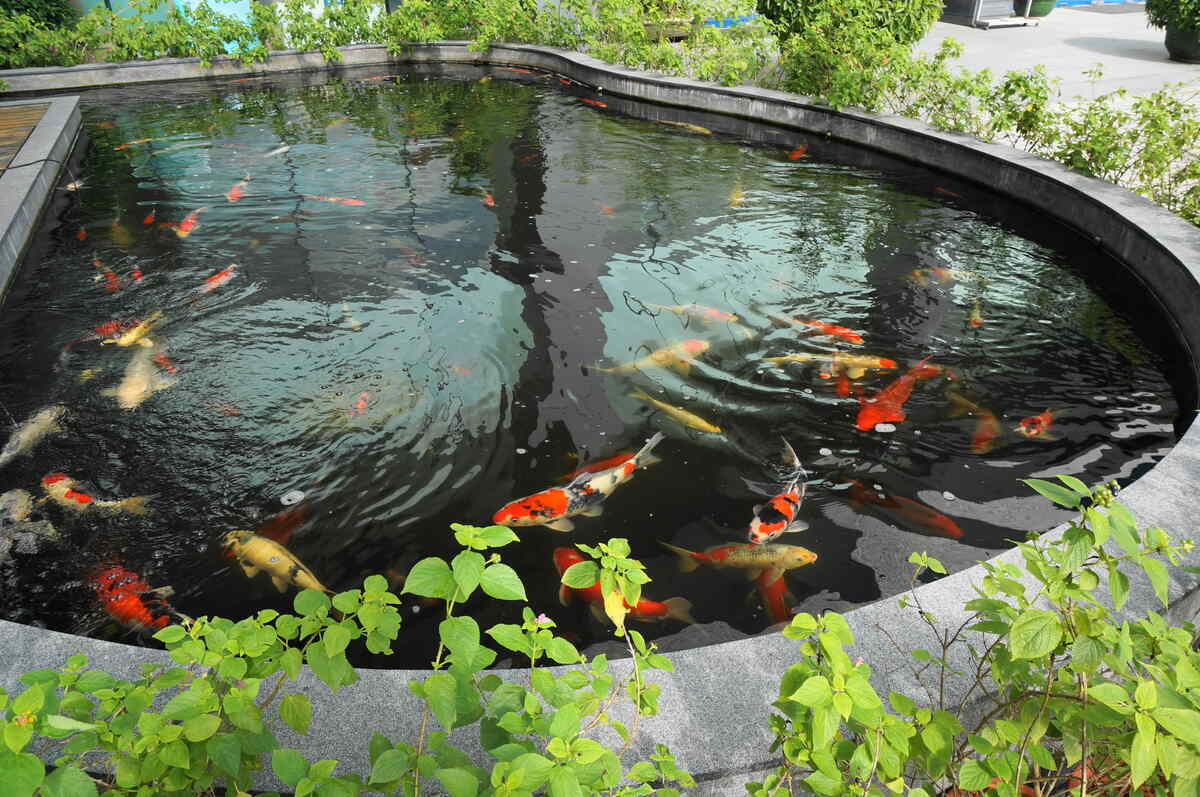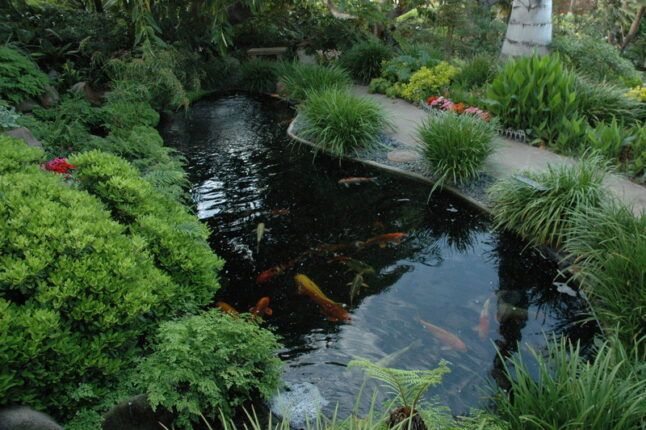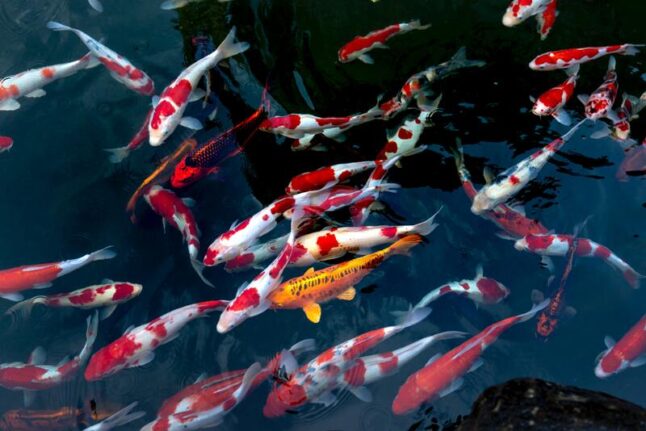
A koi pond is a beautiful water feature specially built for raising koi fish. Some say it’s “a koi swimming pool.” Others describe it as an oversized fish tank. It’s at least 4 feet deep, 7 feet by 8 feet or larger, and uses a rubber or concrete liner to keep the water in. In this article, we’ll tell you what a koi pond is and the details of how it works.
A koi pond includes a high-quality filtration system and houses colorful, hearty koi that swim all day and eat from your hand. Most homeowners get an outdoor koi pond for its positive energy vibe, stress relief effect, and increase in property value. In Japan, the koi fish is a symbol of good fortune and prosperity.
What Does a Koi Pond Look Like?
Some koi ponds are built in the ground, and others are partially above the soil. The most exciting raised models have glass windows, so you can see the fish swimming as if you were in an aquarium. Others have bridges passing over the water, letting you watch the fish from above.
Koi ponds are beautifully landscaped with stone, concrete, or wood edging. Colorful water lilies float on the surface, and waterfalls break the silence with a soft, trickling sound. Tall trees shade from the sides, and all the devices that keep the fish healthy are carefully hidden.
A koi pond can look deceivingly similar to a typical garden pond. Except it’s not. Let’s dive in for a second.
On a curious note: “Coy pond” or “koy pond” are common misspellings of koi pond.
Koi Pond’s Shape and Size

Under the water’s surface, a koi pond has perfectly vertical walls. In regular backyard ponds, walls have shelves for placing aquatic plants and rocks. But shelves can be dangerous in koi ponds. Any fish swimming in such shallow areas becomes easy prey for wild animals such as herons and raccoons.
Koi pond walls go down for 4 to 8 feet to keep the fish safe and warm during winter. They can reach 21 feet in bottomless ponds, but fish are harder to enjoy in such deep waters. The pond’s interior is covered in rubber, plastic, or concrete liner.
Its corners are rounded, and the base has a concave profile leading to a bottom drain. This shape prevents debris from clogging the corners. It also helps solids travel smoothly to the drain. Now that you know the basics of a koi pond, check out these koi pond design ideas for some creative inspiration to make your pond unique.
How Does a Koi Pond Work?
Healthy and joyful koi need clean, fresh, good-quality water that is rich in oxygen and low in toxic debris. This is where the filter system steps in. Here’s how it works:
Step 1. Collecting Debris
Two devices capture debris and fish waste: the bottom drain and the pond skimmer. The skimmer catches leaves, twigs, and other large debris floating on the surface. The drain sucks in solids falling to the bottom of the pond.
Step 2. Filtration and UV Treatment
From there, water travels through pipes to be filtered mechanically and biologically. The mechanical filter extracts wastes and solids like a vacuum cleaner, while the biological filter uses beneficial bacteria. These turn toxic ammonia from fish droppings and food into less harmful nitrates.
Water is also exposed to ultraviolet light using a UV lamp to prevent algae from blooming and keep the pond crystal-clear.
Step 3. Water Flow
Around the pond, jets, spillways, and waterfalls bring the water back, creating water currents and making life more interesting for the fish. Currents also lead debris from every corner toward the skimmer and the drain.
The entire water is circulated like this once an hour by an external water pump.
Step 4. Oxygen Sources
As for the oxygen fish need to breathe, waterfalls and aquatic spillways bring it into the pond. Water plants and good algae produce it, too. See this list of the best koi pond plants to choose the best ones for your fish. An aeration system is also added for large koi fish, crowded ponds, and always during winter.
You may be asking, “Isn’t it hard to maintain a koi pond with so many devices at work?” Not really, and this is why.
Koi Pond Maintenance
With a high-quality filter system, a koi pond is low-maintenance. Everything works like a well-oiled machine and requires only small gestures of attention, such as:
- Feeding the fish
- Enjoying and observing their elegant swimming to make sure they are healthy
- Measuring water temperature
- Checking and cleaning the skimmer
This can be an easy and relaxing daily routine.
Once a month, pond filters, the water pump, and the UV light need checking. The pond also requires a full cleanup twice a year. Plus, you have to prepare the pond for winter when the season changes. Some koi pond owners prefer to learn and do this DIY. If you’re ok with getting your hands a little dirty, check out our koi pond maintenance guide.
Homeowners also have the option of hiring a pro to do the maintenance. Professional pond maintenance costs from $810 to $2,625 per year, or from $170 to $450 per month if you get a monthly plan.
Where Can You Install a Koi Pond?
Koi ponds are typically backyard landscape features since side yards are too small. You need an area of at least 7 feet by 8 feet where you can dig 4 feet deep or more without damaging utility lines.
Because it’s built to be seen and experienced, a koi pond should be visible from inside the house or from the deck or patio. Can you see a place for it in your garden?
Starting Your Koi Fish Pond
Planning is the first step and the most important. You choose a proper location and decide the size of the pond and landscaping features. At this point, you also determine if it’s a DIY project or if you’ll work with a contractor to build the koi pond. The average cost for professional koi pond installation is $5,100 to $15,875.
If that price is too high, learn how to install a small backyard pond yourself. The next step is to choose the best filtration system for the pond’s water volume and the materials to use when building it.
Finally, construction starts and the pond begins to take shape. It’s exciting! But don’t rush the fish in just yet. A koi pond is only ready to receive new fish when:
- Everything is installed
- The interior has been cleaned thoroughly of construction debris
- Water has been added and tested
Make sure to acclimate koi fish by preparing them slowly for the water temperature in the pond.
What Are Koi Fish?

Koi fish are colorful ornamental fish originally from Japan. Their name comes from the word “Nishikigoi,” which means brocaded carp. Long ago, Nishikigoi was an ordinary gray species cherished for its protein-rich meat. It started mutating into beautiful, lively-colored varieties only in the 18th century. Now, they are considered “living jewels.”
Traditionally used in Japanese gardens, koi ponds are now widespread in outdoor water gardens everywhere.
Healthy koi fish require:
- A temperature of 60 to 75 degrees Fahrenheit
- An oxygen-rich environment
- A balanced mix of shade and sunlight.
Feeding koi fish is easy. They eat various bugs, insects, larvae, algae, and fish feed, but they can also eat vegetables, cereals, and fruits.
Other Types of Fish You Can Grow in a Koi Pond
Some pond owners want a more complex ecosystem and mix other fish types with koi. The most suitable koi pond mates are:
- Comet goldfish
- The common catfish
- Grass carps
- Orfe
- Largemouth bass
Swimming in a Koi Fish Pond
Swimming or snorkeling along with the pretty Japanese fish on a hot summer day can be a dream come true. If the idea tempts you, consider this option before installing the pond. You might want a larger one.
Also, keep in mind there are some disadvantages and risks in using your koi pond as a pool. First, you might stress the fish. So, try not to interact with them while in the pond. Also, the water can be cold for swimming.
You must be careful not to cut yourself while swimming or enter the water with open lesions. Despite filtration, there might be some dangerous bacteria, and your wound could become infected.
Why Should You Get a Backyard Koi Fish Pond?
A koi pond is a healing and detoxifying retreat, perfect after a stressful day. Water sounds and the languid fish swimming are relaxing and soothing for the mind.
Koi ponds are also great for children learning to interact with wildlife and care for other creatures (without being too demanding). Koi are active and joyful and can be taught to come and eat from their hands.
Installing a koi pond can also increase property value. And it’s safe to say that with a koi pond in your own backyard, you’d be the envy of the neighborhood.
FAQ About Koi Ponds
Can You Fill a Koi Pond with Tap Water?
Tap water can be used to fill a koi pond, but you need to dechlorinate it using a water conditioner. Make sure the conditioner neutralizes both chlorine and chloramine, or call the local water treatment company and find out which substance they are using.
Does Your Koi Pond Need a Waterfall?
A koi pond needs water agitators to provide oxygen for the fish. You can choose between waterfalls, water fountains, water bubblers, a bottom drain with an aerator, etc. It can be something other than a waterfall, but most pond owners choose it for the visual effect.
How Long Do Koi Fish Stay Alive?
Domestic koi kept in outdoor ponds live 15 to 20 years, while imported Japanese koi can reach 40 years. In smaller and more crowded ponds, koi fish don’t live as long.
Do You Feed Koi Every Day?
Experts recommend feeding koi fish in ponds once a day. Avoid spreading too much fish food since what remains ends up feeding the algae and causing them to bloom.
To learn more about koi ponds, see our answers to the top 10 koi pond FAQs.
Call a Landscaping Pro
Do you want to relax by a koi pond without the hassle of installing one? Hire a landscaping professional to install or maintain your pond. That way, you can fully enjoy the beauty of fish swimming in your own personal water oasis.
Main Photo Credit: Winslowchen / Wikimedia Commons / CC BY-SA 3.0